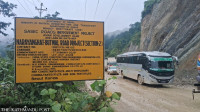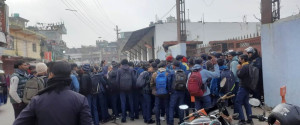National
Pandemic cut Nepal life expectancy by three years
Decline almost double the global average during the pandemic period, says The Lancet report.
Arjun Poudel
The Covid-19 pandemic reduced the average life expectancy of Nepali people by nearly three years between 2019 and 2021, a report published by The Lancet, a leading international medical journal, shows.
The decline is almost double the global average, which is 1.6 years, according to the report.
Nepal’s life expectancy at birth increased by six years from 2000 to 2021—65.3 years in 2000 to 71.3 in 2020—according to the World Health Organisation.
However, the report, titled “Global age-sex-specific mortality, life expectancy, and population estimates in 204 countries and territories and 811 subnational locations, 1950-2021, and the impact of the Covid-19 pandemic: a comprehensive demographic analysis for the Global Burden of Disease Study 2021” published last month shows that average life expectancy of Nepali people stood at 68.4 years for both sexes—70.8 years for females and 66.1 years for males in 2021.
“This is a severe blow to the progress we made over the years through great effort and billions in investments,” said Dr Keshab Deuba, a public health epidemiologist, who is also a co-author of the report. “The report indicates that our health system is not prepared to handle a Covid-19 pandemic-like catastrophe and our progress could reverse at any time.”
The report shows that all-cause mortality rates declined between 1950 and 2019 and increased during the Covid pandemic period (2020–21) throughout the globe. In contrast with the overall reverse in mortality trends during the pandemic period, child mortality continued to decline.
“Global adult mortality rates markedly increased during the Covid-19 pandemic in 2020 and 2021, reversing past decreasing trends, while child mortality rates continued to decline, albeit more slowly than in earlier years,” reads the report.
Public health experts in Nepal said that continuation of routine vaccination, improvements in water and sanitation conditions, better nutrition and increased awareness can be credited for the decline in under-five mortality.
The Nepal Demographic and Health Survey-2022 carried out by the Ministry of Health and Population shows that under-five mortality rate has declined to 33 from 39 in 2016 and infant mortality rate to 28 from 32 in 2016, in every 1,000 live births.
The Lancet report estimated that 131 million people died globally from all causes in 2020 and 2021 combined, of which 15·9 million were due to the pandemic.
Deuba said excess mortality rates exceeded 1.5 deaths per 1,000 population during at least one year of the pandemic, which is higher than would be expected based on historical trends.
The Covid pandemic death toll includes fatalities that occurred directly due to SARS-CoV-2 infection and those caused indirectly due to other social, economic, or behavioural changes associated with the pandemic.
Excess mortality rates exceeded 150 deaths per 100,000 population during at least one year of the pandemic in 80 countries and territories, whereas 20 nations had a negative excess mortality rate in 2020 or 2021, indicating that all-cause mortality in these countries was lower during the pandemic than expected based on historical trends.
“Between 1950 and 2021, global life expectancy at birth increased by 22·7 years from 49 years to 71·7 years,” reads the report. “Global life expectancy at birth declined by 1·6 years between 2019 and 2021, reversing historical trends.”
An increase in life expectancy was only observed in 32 of 204 countries and territories between 2019 and 2021. The global population reached 7·89 billion in 2021, by which time 56 of 204 countries and territories had peaked and subsequently populations have declined.
In the meantime, India’s life expectancy at birth declined by only 1.8 years between 2019 and 2021, which is lower than Nepal.
Deuba said that the comprehensive demographic estimates reported in the report is expected to enable researchers, policymakers, health practitioners, and other key stakeholders to better understand and address profound changes that have occurred in the global health landscape following the first two years of the Covid pandemic, and longer-term trends beyond it.
“The lesson is that we should be well prepared and our health system should be resilient to deal with any adverse situations like the coronavirus pandemic,” said Deuba. “Otherwise, achievements we made over the years could reverse.”




 9.12°C Kathmandu
9.12°C Kathmandu









%20(1).jpg&w=300&height=200)





